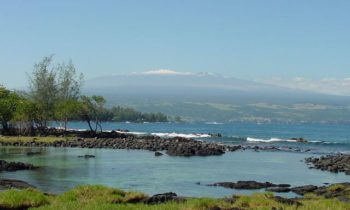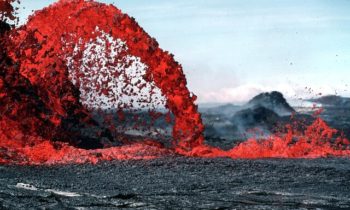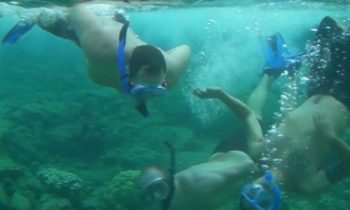Hey Braddah, you can swim?
Uh swim… Yeah I can swim. Why?
We go da kine beach tomorrow, Brah you like go?
Yeah I’d love to. I’ve been here for over a week and haven’t gone yet.
OK we go North Shore tomorrow. OK….. Sounds great.
I’ll never forget this conversation. I’d been working on Oahu for a few weeks up in the hills above Mililani, and still hadn’t been to a single beach.
To be honest, surfing or boogie boarding on the North shore of Hawaii would not have been my first choice. I actually was looking at something easier like Waikiki.
Yet, as a transplant from southern California, I had surfed and boogie boarding many times before. However going out with some locals, who had extra boards and years of experience, seemed like a pretty safe bet.
As soon as I got out of the back of the truck, I realized that this was no San Onofre or Manhattan Beach. I’m not saying that Southern California doesn’t have great surf, but compared to what awaited me, it was no contest.
Beware water shaped like waves.
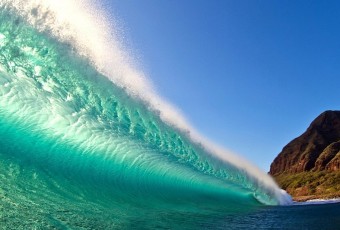 Standing on the beach, I realized there was no way I was going to try surfing today, not even on a long board. Even a boogie board seemed like a bad idea. Even the guys with me recommended not going out today. For some reason they chose Waimea Bay (probably because sunset was too big that day).
Standing on the beach, I realized there was no way I was going to try surfing today, not even on a long board. Even a boogie board seemed like a bad idea. Even the guys with me recommended not going out today. For some reason they chose Waimea Bay (probably because sunset was too big that day).
Now Waimea is a nice beach, but it was January and the swells were coming out of the west. Typically this causes larger and steeper waves. Riding Waimea is often made up of huge drops and shorter rides.
Basically you catch the wave as quick as you can, make a huge drop down the face, then a quick cut out on the bottom towards the deeper water of the channel. It’s not a long ride, but it is intense.
I watched the guys paddle out, and ride for a while. Since the waves appeared to be only about 6-8 feet, I decided it was safe to go out for a quick swim. At first it was nice, swimming around enjoying the sun and surprisingly warm water. At this point in my life, I was in really good shape and could stay in the water for hours.
Then, for some reason, I decided to swim out to the breaks and check on my friends. It wasn’t too tough at first. You just dive under each wave, come up for air, swim for a bit, dive under another wave, and out you go.
Swimming over, one of the guys invited me to hang onto his board for a bit and “talk story”. I stayed out beyond the break a few sets and spent time talking. You see surfing includes a lot of waiting, which makes it a great social sport. This is because waves are grouped in “sets”, typically 3 to 4 at a time, and are spread out over time.
It was nice being out in the water, yet after a while I noticed the waves were starting to increase in size. The oldest of the guys, Kaiwika (David), asked me if I needed help back, and being a typical guy I told him it was no problem.
Easier getting out than in.
I waited for the last set to end, and then made my mad dash back to shore.
However what I wasn’t prepared for was the massive size or strength of the waves. At one point I had to swim down to the bottom and hang onto the coral, until the wave passed. This had to be done 3 or 4 times in a row as the sets came in. However, when the waves stopped, the choppiness and turbulence of the water did not. It was like trying to swim inside a blender in front of a waterfall.
This went on for some time, and I began to wonder if my conditioning was all I had thought it was. I was beginning to wonder if it was time to call for help. Besides all this, holding on coral with bare hands was like holding onto rocks made of sand paper inside a storm.
Not only was my body getting tired, but now my hands were bleeding. I could see the shore just a short distance away. At one point in all this madness, I started to think about the movie Jaws, and how it was the blood in the water that turned the white shark into a giant killing machine. By this point, I was beginning to feel the overwhelming fear of death by drowning and shark attack at the same time.
I’d just about reached the point of screaming for help, when I noticed how close I really was to shore. Then this remarkable thought came to mind, “why don’t you try to stand up”.
So I stopped swimming, righted myself by treading water, and noticed my foot started to touch this weird soft stuff called sand. Well if that didn’t beat all. I nearly had given up and possibly drowned in five feet of water.
By the time I got to shore, I wanted to stagger out of the water and fall face-first in the sand. But the Macho man in me attempted to saunter out of the water looking like I meant to swallow salt water, bleed on the sand and nearly drown my first day at the beach.
I slowly and nonchalantly walked back to my towel. I wanted it to appear like nothing had happened. But in my mind I realized that this might have been the last day I spent in Hawaii and on planet earth! Of course I learned a valuable lesson that probably kept me alive after 25 years in Hawaii.
And that is never, ever, ever, underestimate the power of water.
Enjoying Hawaii’s water and living to tell about it.
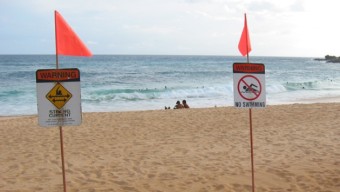 Now water is a great thing, especially when it is pure, clear and calm. Yet add lots of salt, sea weed, rocks, cliffs, coral, dangerous creatures, wind, pressure, vibration, and lots and lots of movement and water can become a terrifying deadly thing. Just ask the 60 people who drown each year in Hawaii. Oh wait, you can’t, because their dead!
Now water is a great thing, especially when it is pure, clear and calm. Yet add lots of salt, sea weed, rocks, cliffs, coral, dangerous creatures, wind, pressure, vibration, and lots and lots of movement and water can become a terrifying deadly thing. Just ask the 60 people who drown each year in Hawaii. Oh wait, you can’t, because their dead!
Now my heart goes out to all those lost in water related deaths. I have a good friend who lost his son to the ocean, and one who lost his wife to a waterfall. Because of accidents like these, I cannot over emphasize the dangers that lurk in and around the various forms of water in Hawaii.
Remember, the State of Hawaii is made up of 8 islands in the middle of the Pacific Ocean. This makes them not only surrounded by water on the outside but the inside as well. The interior of Hawaii is made up of many rivers, streams, waterfall, ponds, and pools that criss-cross the interiors.
Due to their location, each island has a wet side and a dry side. Places like Hilo can get well over 150 inches of rain each year. While the Kona side gets only a few inches. However, even with “dry sides”, the average rainfall in Hawaii is an astounding 62.73 inches each year.
Yet regardless of the amount of water, it’s the ferocity of water that matters.
You know a little rain can be soothing; a lot of rain can be disastrous. Sitting next to a waterfall can be relaxing, falling into one is deadly. Sitting on a beach can be calming; swimming in the ocean can be tumultuous.
So remember waves are not only limited to oceans. I have seen rain so hard that it comes at you like waves. I have even boogie boarded under waterfalls, and kayaked down the waves of rivers.
This is why no one should ever swim, snorkel, surf, dive, fish, hike, boat or explore the many water related adventures without bringing a friend along or at least telling someone where you are going. I also recommend having the proper gear with you when you go out. Let’s take a look at a few tips.
Hawaiian Adventures 3: Enjoying Hawaii’s Water: Tips and other good ideas.
Boating, Jet ski, Kayaking, Snorkeling
- Always let someone know where you are going and when you plan to come back (that way they know when and where to go looking for you, if you have problems).
- Know your equipment. (Since many people rent equipment, make sure you get a good overview of how the equipment works)
- Before you go out it’s a good idea to check the weather report, tidal schedules and be ready because Hawaii’s weather can change very quickly.
- Bring a water proof bag for your cell phone and any emergency supplies you may need.
- For kayaking and snorkeling always stay near the shore and stay close to shallow water (It’s hard to get back if you can’t see the shore).
- For Jet Skis always wear a life vest, beware of who and what’s around you, and never go out past the shoreline because they can break down and run out of gas (trust me I’ve been there)
- For equipment based water activities always bring a life jacket and have enough supplies for emergencies (i.e. water, snacks, sun screen, ear plugs, emergency kit etc).
Hiking (especially near water).
- Always wear decent shoes (not slippers, because slippers are unstable and slippery when wet).
- Bring a small pack with water, some snacks, cell phone for emergencies, sun screen, bug repellent, and a wind-breaker (for wind and rain).
- If you’re going out longer - a pocket knife, flash light, matches and a light rope may come in very useful.
- Stay away from the edges of any waterfall, cliff, crater etc.
- Also always let someone know where you are going and when you plan to be back.
- You can also sign in with many of the ranger stations or entrances to trails around the islands. This way people will miss you and come looking for you if you don’t return at the right time (trust me this happens more often than you think).
Swimming in rivers and near waterfalls.
- Never swim under or into waterfalls (there are many ways to get pushed down and trapped under water).
- If you have to dive, never do so alone and make sure to physically check the depth.
- Get information from locals on where it’s safe to swim, before you go out (the people of Hawaii are typically very helpful, so don’t be afraid to ask)
- Never judge the water by its appearance. It may seem calm above, but can be raging underneath (remember the old adage when in doubt, don’t).
- Never ever step into or swim in water directly above a waterfall.
- Remember Hawaii has flash floods (so check the weather report before hand).
Fishing:
- When fishing near cliffs never ever forget where you are, or how unstable cliffs may be.
- Research charters before hand, and don’t get caught up in the big catch that you forget the dangers around you.
- Check the tide charts and beware of tidal currents and rogue waves.
- Due to the wide variety of fish and styles of fishing, make sure you do some research into the area where you are fishing beforehand.
- For spear fishing make sure you have the proper equipment, don’t go alone, stay close to shore, and know what you’re aiming at.
Surfing / Boogie boarding safely for beginners:
- Remember Hawaii has many coral reefs, which cause some pretty big waves to flow over shallow shelves.
- So remember when you fall off, or the wave throws you off, you must remember the depth of your surroundings (corral, rocks, and sea urchins are very painful).
- Hawaii waves are very unpredictable and can get very big, very fast.
- Get a lesson, never go out alone, learn on a long board, stay hydrated, be conscientious of other people and surfers, try not to dive/fall head first into the water and wear sunscreen (water makes you burn faster and water proof anything is hard to find).
Finally, remember that Hawaii is an awesome place to experience water, but as the sign always says “Proceed with Caution”.


